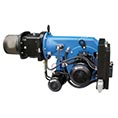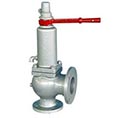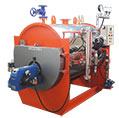The story of the boiler inspection plate:
Due to the large production of non-standard boilers, the purpose of this article is to inform the esteemed boiler buyers about the importance of the boiler inspection plate.
According to the rules of the National Standard Organization, there must be the following items for the production of steam boilers:
The manufacturer must have a license or a standard license with his own national number.
All stages of boiler production must be inspected by qualified companies, and finally, a certificate and inspection plate will be issued for the boiler.
This means that even if a company or manufacturer has a standard license and produces a steam boiler without inspection supervision, it is a non-standard boiler and its production is against the laws of the country.
Boiler and steam boiler inspection programs
learning programs
Large steam production systems require special training programs due to the complexity of controls, valves, precision instruments and the abundance of hardware.
Manufacturers of large steam boilers sell educational programs to owners of large industries and power plants.
According to government laws regarding the permitted amount of polluting substances, which affects the operation of boilers and steam boilers, training by the manufacturer will definitely help the operator in receiving a new unit and using it.
As boiler units become more complex, educational models are used more.
Curator
Most state laws (in the United States of America) stipulate that a full-time or part-time operator must be present when automatic boilers are in operation.
In most states, the concept of attendant presence is as follows: water tube boilers with a capacity of more than 2000 1b/hr, and boilers using circulating coal, must have full-time attendants.
High-pressure smoke tube boilers must have a full-time or part-time operator.
Full-time presence means the presence of an experienced operator who never leaves the boiler room for more than 20 minutes.
Half-time attendance means that the operator may leave the boiler area for more than 20 minutes, and leave the boiler alone in operation.
But review it at least once every 2 hours.
Another is used carelessly, they say that it is used for a period of more than 2 hours without the presence of an experienced operator to review its work.
State and municipal laws should be reviewed in the regulations related to the presence of the boiler operator.
Operator training:
Where there are no regulations for the presence of attendants, the best thing to do is to familiarize and train the relevant attendants with the following minimum regulations:
1- Tracing and drawing the fuel system of the steam boiler and related valves, strainers, measuring and control devices.
2- Tracing and drawing main and auxiliary water steam systems, return water systems and boiler feed water, including valves, measuring devices, controls and control interfaces.
3- Inspection and testing of exterior walls and coatings.
4- Inspection of the surfaces of the water side of the combustion gases in terms of leakage, corrosion, cracks, swelling, blisters, and other conditions that weaken the steam boiler.
5- Cleaning, inspection and testing of gas-burning oil burners and their outlet pipes.
6- Reviewing the fuel tanks, and if necessary, cleaning the filters, fuel lines and equipment.
7- Regulation of fuel recirculation system, review in terms of leakage, fuel system disconnection test, review of flame protection devices.
8- Observing and recording the pressure and temperature of the fuel system, reviewing and measuring the adjustment points of the controls.
9- Inspection and operation of soot cleaners in a suitable way.
10- Firing, reducing the fuel and keeping the coal low in the coal-burning steam boiler (if this type of boiler is installed.)
Continuation
11- Inspecting and measuring the work of the coal grill and mill in a coal-burning boiler, checking the control system and the interface systems between them.
12- Setting up, measuring and tightening the blowing and suction fans, checking the proper functioning of the controls, and the interface systems between them.
13-Inspection of the final channels of combustion gas and chimneys.
14- Determining the pressure of the furnace, the wind box and the created pressure difference, as well as the temperature of the furnace and chimney; If necessary, adjust the production pressure difference.
15- Sampling and analysis of combustion gases to determine the values of CO2, CO and O2, interpreting the results and making necessary corrections.
16- Evacuation, both from the bottom of the boiler and from the free surface of the water in it.
17- Draining the water from the glasses and water-view columns.
18- Testing the warning devices related to the decrease and increase of the water level, as well as the fuel cut-off key related to the lack of water, installing and cleaning the warning device and the mentioned key.
19- Regulating feed water pumps and auxiliary pumps and measuring feed water regulating devices.
20- Regulating the water level of boiler and steam boiler.
Continuation
21- Activating, adjusting, tightening the steam water level regulator.
22- Testing of safety valves.
23- Putting the boiler on the line.
24-Heating (entering the circuit) and cutting water vapor lines.
25- Removing the steam boiler from the line, pulling out the fire from the furnace (for coal-burning boilers), and bringing the boiler under control.
26- Conduct boiler water analysis, interpret the obtained results, process the feed water and, if necessary, regulate the continuous draining of the boiler water.
27- Transferring ignition control from manual mode to automatic mode and vice versa, checking safety controls during work.
28-Preparing daily reports from the boiler and also preparing files from its work.
29- Putting in and out of the circuit of steam heaters in a suitable way.
30- regulating the temperature and pressure of the feed water heater.
Continuation
31- Glass replacement and re-sealing of water-view windows.
32-Removing the door of the front and rear manholes, replacing the waterproofing layers and closing their doors again.
33-Inspection, repair and regulation of safety valves within the scope of regulations.
34-Cleaning the side surfaces of the combustion gases of the steam boiler.
35-Repairing refractory materials and carrying out other renovations related to the furnace.
36-Perform hydrostatic test.
37- Stopping the boiler.
38-Information about replacing the pipe in the steam generating parts, steam heaters, generators, air heater and boiler feed water heater.
39- Regulating the distance of wipers and related fountains.
40- Inspection, cleaning and repair of boiler pressure gauges, precision instruments and controllers.
In addition to the above, the boiler operator should be constantly studying the following materials about boiler inspection:
1- Boiler design and steam system
2- Construction
3- Utilization
4- Repair and maintenance
5- State or city laws
6- Regulations and inspections of the insurance company
7-Emergency measures
8- Safety in a steam production unit
9- ASME regulations related to boiler pressure tank.
































